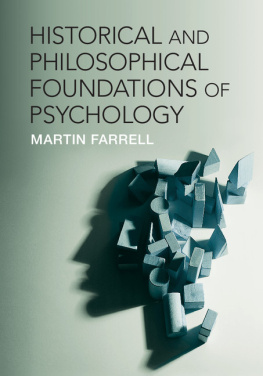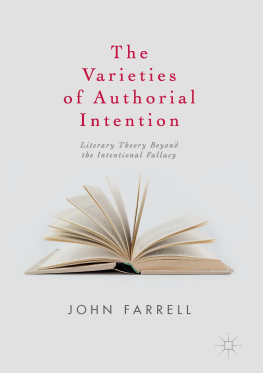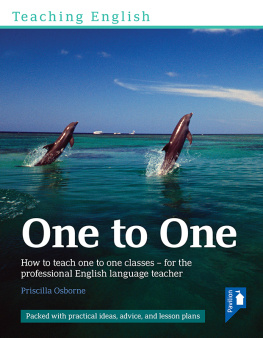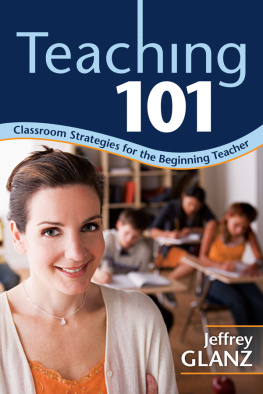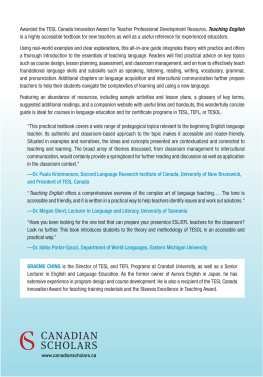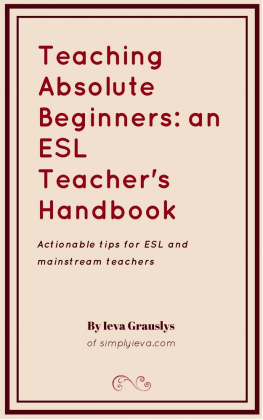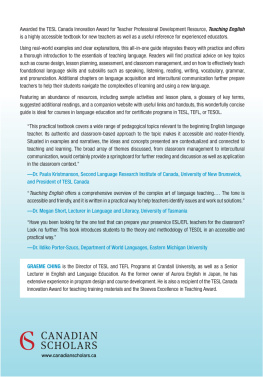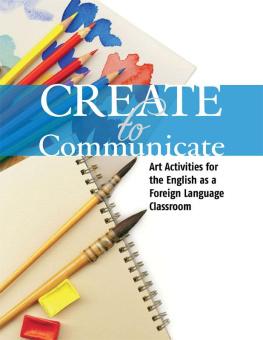Succeeding
WITH English
Language
Learners
Succeeding
WITH English
Language
Learners
A GUIDE FOR BEGINNING TEACHERS
THOMAS S. C. FARRELL

Copyright 2006 by Corwin Press
All rights reserved. When forms and sample documents are included, their use is authorized only by educators, local school sites, and/or noncommercial or nonprofit entities who have purchased the book. Except for that usage, no part of this book may be reproduced or utilized in any form or by any means, electronic or mechanical, including photocopying, recording, or by any information storage and retrieval system, without permission in writing from the publisher.
For information:
 | Corwin Press
A Sage Publications Company
2455 Teller Road
Thousand Oaks, California 91320
www.corwinpress.com |
Sage Publications Ltd.
1 Olivers Yard
55 City Road
London EC1Y 1SP
United Kingdom |
Sage Publications India Pvt. Ltd.
B-42, Panchsheel Enclave
Post Box 4109
New Delhi 110 017 India |
Printed in the United States of America
Library of Congress Cataloging-in-Publication Data
Farrell, Thomas S. C. (Thomas Sylvester Charles)
Succeeding with English language learners: A guide for beginning teachers/Thomas S. C. Farrell.
p. cm.
Includes bibliographical references (p.) and index.
ISBN 1412924383 (cloth: acid-free paper) ISBN 1412924391
(pbk.: acid-free paper) 1. English languageStudy and teachingForeign speakersHandbooks, manuals, etc. I. Title.
PE1404.F359 2006
428.0071dc22 2005015863
This book is printed on acid-free paper.
05 06 07 08 09 10 9 8 7 6 5 4 3 2 1
| Acquisitions Editor: | Faye Zucker |
| Editorial Assistant: | Gem Rabanera |
| Production Editor: | Beth A. Bernstein |
| Copy Editor: | Brenda Weight |
| Typesetter: | C&M Digitals (P) Ltd. |
| Proofreader: | Andrea Martin |
| Indexer: | Teri Greenberg |
| Cover Designer: | Rose Storey |
Contents
Preface
I t has now been long established in general education research that learning to teach is a complex process and the first years of teaching have an important impact on the future careers of beginning teachers. Studies on teacher socialization all agree on one issue: beginning teachers need assistance in the form of support during their first years of teaching. The primary purpose of Succeeding With English Language Learners: A Guide for Beginning Teachers is to provide crucial support for English language teachers at all levels in their first years to help make the transition from the teacher education institution to the real classroom smoother.
Another purpose for this book is that sometimes teachers of other content areas are either (a) asked to teach English as a second language (ESL) as an extra subject without proper training or certification in teaching ESL or (b) getting more ESL students in their content subject classes and do not know how to teach these students. This book, especially , will give them many strategies for teaching each English language skill area as well as for assessing the progress of their students in English. Thus they will be better placed to serve their less-language-proficient students and be better able to make decisions about whether their students need ESL placement or can be moved into mainstream content classrooms after a period of ESL lessons.
Many books on language teaching present a range of concepts, theories, methods, and techniques without giving readers any specific methods or strategies of language teaching that will get them through their first years as a teacher. In contrast, Succeeding With English Language Learners: A Guide for Beginning Teachers provides practical strategies and examples and also gives beginning teachers insight into what they can expect during their first years as language teachers, inside and outside the classroom. The book is grounded in theory, yet it is written for new teachers in accessible language and provides strategies they can implement immediately by engaging in the exploratory breaks. Later they can read the theory that supports the strategies they implement in their classes, as each strategy is explained and referenced. In other words, the book is user friendly for new teachers.
The main thesis of Succeeding With English Language Learners: A Guide for Beginning Teachers is that a strategic approach to teaching speaking, grammar, writing, and reading to all these students can help them better cope. Additionally, teachers in their first years can find easy-to-use techniques that they can put into action immediately and, if they are interested (and have time), they can look up the list of references so they can further develop this strategic approach to their teaching.
Each chapter in Succeeding With English Language Learners: A Guide for Beginning Teachers is clearly structured to help language teachers in their first years navigate clearly through the text. The first chapter provides a case study of one language teacher as a backdrop to the important issues of stages of development and support that many first-year language teachers typically face. They also learn what to expect from colleagues, the school, and the community.
Additional chapters provide first-year teachers with ideas on lesson planning ( discusses language assessment and outlines various ways language teachers can test oral and written language. The final chapter of the book, Professional Development, deals with the future development of teachers in their first years by offering them the tools to become reflective practitioners.
Although Succeeding With English Language Learners: A Guide for Beginning Teachers is suitable for both preservice and second and foreign language teachers in their first years of teaching, it is also suitable for ESL and English as a foreign language (EFL) teachers in the primary and secondary grades who need a refreshing look at what they do. This audience can include teachers who are teaching in ESL pull-out programs or even in subject-area immersion classrooms that include native English speakers in addition to ESL learners. Although many of the examples used in each chapter are from both ESL and EFL settings, teachers of any second or foreign language will benefit from reading this book. The book can be used as a text in both undergraduate and graduate education, language, and/or linguistics courses (language arts, MED, MA, TESOL, etc.). This book can be used by nonnative and native speakers of English.
I have outlined strategic approaches to teaching all the skill areas in each chapter. It should be noted, however, that these activities should be taken only as suggestions and not as prescriptions. Teachers are invited to adapt and create their own exercises after each strategy has been explained. These strategic approaches are equally applicable to teachers of very young learners, teachers of teens, and teachers of adults. In many cases, all teachers must do is make small and simple modifications to the strategic approach that is presented so that it suits a particular group of students. This is the main reason why these strategic approaches are included in this book. I hope you enjoy Succeeding With English Language Learners.
Thomas S. C. Farrell
ACKNOWLEDGMENTS
Next page



